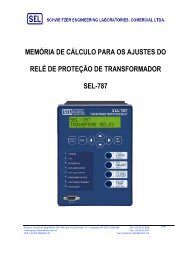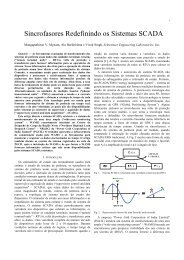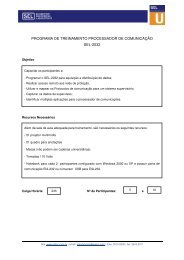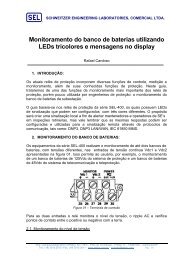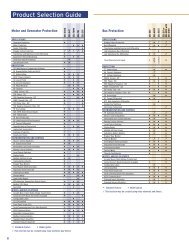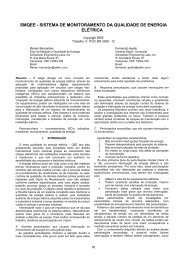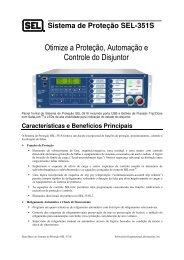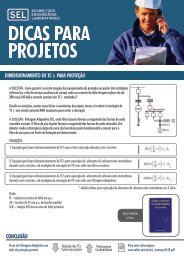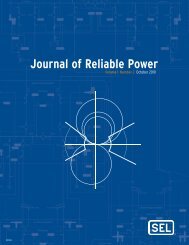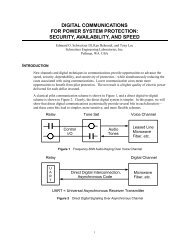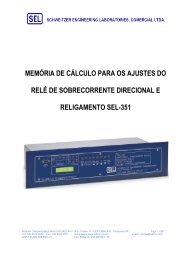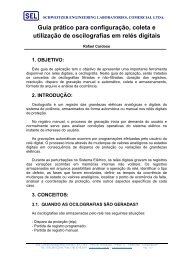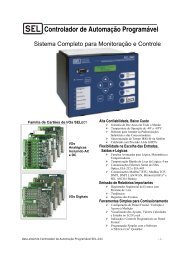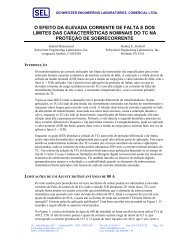Journal of Reliable Power - SEL
Journal of Reliable Power - SEL
Journal of Reliable Power - SEL
You also want an ePaper? Increase the reach of your titles
YUMPU automatically turns print PDFs into web optimized ePapers that Google loves.
2<br />
II. COMMON ZONE TIMING<br />
In June 2006, a fault occurred just past the remote terminal<br />
on a two-terminal 138 kV transmission line. The directional<br />
comparison blocking (DCB) scheme was disabled at the time<br />
<strong>of</strong> the fault. Because the fault was within the Zone 2 reach, we<br />
expected a trip within the Zone 2 delay <strong>of</strong> 25 cycles.<br />
Event data from the local relay are shown in Fig. 3. The<br />
event data capture was triggered at Cycle 4 by the Zone 2<br />
phase distance element (M2P). The relay tripped and reported<br />
Zone 2 and time targets 0.5 cycles later.<br />
IA IB IC<br />
IGMag<br />
VA(kV) VB(kV) VC(kV)<br />
Digitals<br />
2000<br />
0<br />
-2000<br />
750<br />
500<br />
250<br />
0<br />
100<br />
0<br />
-100<br />
Fig. 3.<br />
IN105<br />
IN106<br />
TRIP<br />
52A<br />
Z2T<br />
Z2GT<br />
Z2G<br />
M2PT<br />
M2P<br />
IA IB IC IGMag VA(kV) VB(kV) VC(kV)<br />
.5 cycles<br />
0 1 2 3 4 5 6 7 8<br />
Cycles<br />
Event Data From 138 kV Transmission Line Relay<br />
Unlike the ground fault in Section I, which evolved into a<br />
larger magnitude fault <strong>of</strong> the same type, this fault evolved<br />
from a single-line-to-ground fault to a phase-phase-ground<br />
fault.<br />
Distance relays support two philosophies <strong>of</strong> zone timing:<br />
independent or common timing (see Fig. 4). For the independent<br />
timing mode, the phase and ground distance elements for<br />
each zone initiate independent timers. For the common mode,<br />
the phase and ground distance elements for each zone drive a<br />
common timer. The common zone timer is suspended for<br />
1 cycle if the timer input drops out. This feature prevents timer<br />
reset when a fault evolves [3].<br />
Suspend Timing<br />
during the fault transition period, and the common zone timer<br />
was suspended. The M2P element then asserted, the common<br />
zone timer resumed timing, and a trip was issued 0.5 cycles<br />
later. In this example, the benefit <strong>of</strong> common zone timing was<br />
a total relay response time <strong>of</strong> 25.5 cycles instead <strong>of</strong> the<br />
expected 50.5 cycles if we had chosen to use independent<br />
timing.<br />
In this event, the fault location estimate from the relay was<br />
accurate despite the evolving fault data. The contiguous fault<br />
data were roughly from Cycle 4 to 7, which was the window<br />
<strong>of</strong> time the triggering element M2P was asserted. During that<br />
time, the fault had already evolved, and the fault data were<br />
stable.<br />
In Fig. 5, the fault location estimate is plotted for the two<br />
different fault types experienced. Both estimates produce<br />
roughly the same fault location when data are stable. But from<br />
Cycle 2.5 to 3.5 you can see where both estimates veer wildly<br />
from the actual location because <strong>of</strong> the fault type evolution.<br />
The reported location from the relay would have been in error<br />
if it had selected data from that time.<br />
m<br />
m<br />
3.5<br />
2<br />
Single-Line-to-Ground Faults (BG)<br />
0<br />
0 1 2 3 4 5 6 7 8<br />
Cycles<br />
2<br />
Phase-to-Phase Faults (BC)<br />
0<br />
0 1 2 3 4 5 6 7 8<br />
Cycles<br />
Fig. 5. MathCad Fault Location Estimates for BG and BC Fault Types<br />
Event data can be replayed as IEEE COMTRADE files<br />
through test equipment into relays. Unique or challenging<br />
fault cases should be archived as IEEE COMTRADE files and<br />
used to test new relays, challenge standard schemes, and<br />
understand relay responses.<br />
M2P<br />
Z2G<br />
Fig. 4.<br />
Z2D<br />
Z2PD<br />
Z2GD<br />
Independent and Common Zone Timing Schemes<br />
0<br />
0<br />
0<br />
Z2T<br />
M2PT<br />
Z2GT<br />
We can deduce from the data in Fig. 3 that the initial fault<br />
had been present, and the Zone 2 ground distance element<br />
(Z2G) had been timing for 24.5 cycles before the fault<br />
evolved. All distance elements dropped out for 0.5 cycles<br />
III. RECLOSE FAILURE<br />
In May 2006, a 34.5 kV line feeding a hospital failed to<br />
reclose for a line fault. The relay was set for two reclose<br />
attempts.<br />
Event data from the relay are shown in Fig. 6. The event<br />
started as an A-phase-to-ground (AG) fault and evolved to a<br />
B-phase-to-ground (BG) fault. This was most likely caused by<br />
a slapping conductor or tree contact. At fault inception, an instantaneous<br />
ground overcurrent element (67G1) asserts and<br />
produces a trip output. At this same time, the relay enters the<br />
reclosing cycle state (79CY), indicating that reclosing openinterval<br />
timing has been initiated. However, we can see that as<br />
the AG fault progresses to a BG fault, the 67G1 element drops<br />
out for 0.75 cycles before reasserting. When the 67G1 element<br />
Lessons Learned Analyzing Transmission Faults | 53



